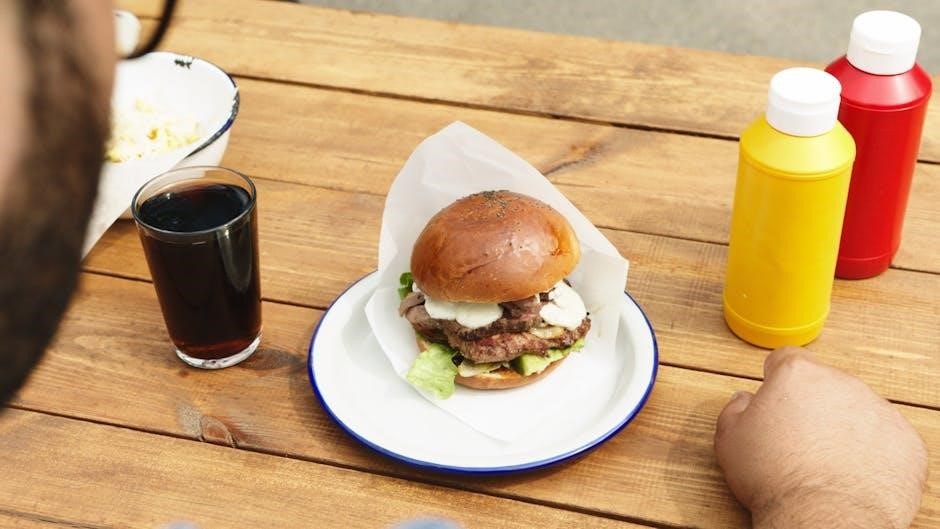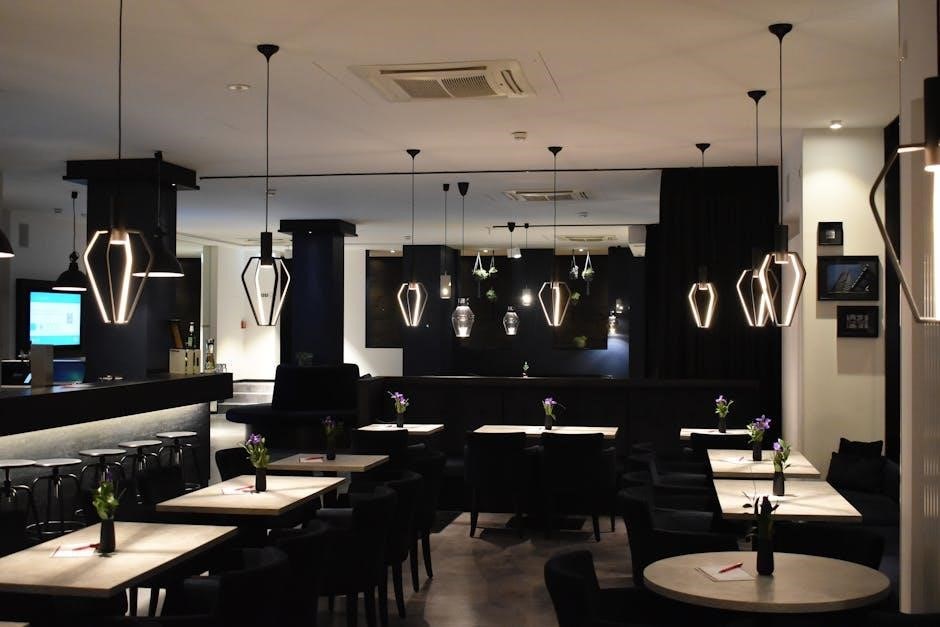Dining out on a low sodium diet requires careful planning and awareness of hidden sodium sources in restaurant meals. By making informed choices‚ you can enjoy flavorful‚ healthy meals while maintaining sodium balance.
Importance of Sodium Awareness
Recognizing the importance of sodium awareness is crucial for maintaining a healthy diet‚ especially when dining out; Excessive sodium consumption can lead to serious health issues‚ such as high blood pressure‚ heart disease‚ and kidney problems. Many restaurant meals are high in sodium due to added salts‚ broths‚ and sauces‚ making it essential to be mindful of menu choices. Sodium awareness helps individuals make informed decisions‚ ensuring their meals align with dietary goals. This is particularly vital for those with medical conditions requiring sodium restriction. By understanding sodium content‚ diners can better navigate menus and communicate effectively with servers to request modifications. Awareness also empowers individuals to balance their intake across meals‚ promoting overall well-being and reducing long-term health risks.
Challenges of Dining Out
Dining out while managing sodium intake presents several challenges. Many restaurants lack detailed nutrition information‚ making it difficult to assess sodium content. Hidden sodium in sauces‚ seasonings‚ and processed ingredients can make even seemingly healthy options unsuitable. Additionally‚ menu items are often prepared with high-sodium ingredients like soy sauce‚ cheese‚ or bacon‚ which are hard to avoid. Portion sizes in restaurants are typically larger‚ increasing overall sodium intake. Communication barriers with servers about sodium content or preparation methods can also complicate decisions. Furthermore‚ the social nature of dining out may lead to less control over food choices‚ making it harder to stick to low-sodium guidelines. These challenges highlight the need for awareness and proactive strategies to navigate restaurant meals effectively.

Understanding Sodium Content in Restaurant Meals
Restaurant meals often contain high sodium due to cooking methods‚ ingredients‚ and portion sizes‚ making it crucial to understand sodium content for informed dietary choices.
Why Restaurant Foods Are High in Sodium
Restaurant foods tend to be high in sodium due to the use of preservatives‚ cooking broths‚ and high-sodium ingredients like soy sauce or cheese. Many dishes are prepared with salt for flavor enhancement‚ and sauces or seasonings often contain hidden sodium. Additionally‚ processed meats and breaded items commonly found in restaurants are typically high in sodium. Portion sizes also play a role‚ as larger servings mean more sodium intake. Furthermore‚ restaurants may not always provide nutrition information‚ making it difficult for diners to assess sodium content. Understanding these factors can help individuals make informed choices and reduce their sodium intake while dining out.
Hidden Sources of Sodium in Menu Items
Hidden sources of sodium in restaurant meals often go unnoticed but can significantly increase intake. Sauces‚ marinades‚ and condiments‚ such as soy sauce or teriyaki‚ are high in sodium. Processed ingredients like cheese‚ breaded items‚ and cured meats also contribute to elevated sodium levels. Additionally‚ many dishes are cooked with broth or stock that contains sodium. Even seemingly healthy options‚ such as salads‚ can be high in sodium due to dressings or croutons. Bread and rolls served before meals may contain added sodium from preservatives. Awareness of these hidden sources is crucial for making informed choices and reducing sodium intake while dining out. Opting for fresh‚ unprocessed foods and requesting modifications can help minimize exposure to these sneaky sodium sources.

General Strategies for Low Sodium Dining
General strategies for low sodium dining include planning ahead by checking menus‚ opting for fresh‚ unprocessed foods‚ avoiding salty sauces‚ and customizing meals to reduce sodium intake effectively.
Choosing Restaurants with Nutrition Information
Selecting restaurants that provide clear nutrition information is a key strategy for low sodium dining. Many establishments now offer detailed nutritional facts on their websites or menus‚ making it easier to identify low sodium options. Look for restaurants that disclose sodium content per dish‚ as this transparency allows for informed decisions. Additionally‚ chains with nutrition information often have healthier options‚ reducing the guessing game. Prioritize eateries that prioritize dietary transparency‚ as they are more likely to accommodate special requests. Avoid restaurants that lack this information‚ as it may indicate less focus on health-conscious dining. By choosing such restaurants‚ diners can better manage their sodium intake while enjoying meals out.
Opting for Fresh‚ Unprocessed Foods
Choosing fresh‚ unprocessed foods is a cornerstone of low sodium dining. Fresh vegetables‚ fruits‚ lean proteins‚ and whole grains naturally contain less sodium than processed items. These foods are rich in essential nutrients and flavors without added salts. When dining out‚ prioritize menu items that emphasize fresh ingredients‚ as they are generally lower in sodium. Avoid dishes with processed components like canned goods or pre-packaged sauces. Opting for fresh options allows you to enjoy meals with natural flavors while keeping sodium levels in check. This approach not only supports heart health but also enhances the overall dining experience by focusing on wholesome‚ unaltered ingredients.
Avoiding High-Sodium Sauces and Seasonings
Avoiding high-sodium sauces and seasonings is crucial for maintaining a low-sodium diet while dining out; Many restaurant dishes rely on salty condiments‚ marinades‚ and seasonings to enhance flavor‚ which can significantly increase sodium intake. Common culprits include soy sauce‚ teriyaki sauce‚ and seasoned blends. Requesting sauces on the side allows you to control the amount used. Opting for herbs and spices instead of pre-mixed seasonings can also reduce sodium. Additionally‚ ask your server if dishes can be prepared without added salt or high-sodium ingredients. By making these adjustments‚ you can enjoy flavorful meals while keeping sodium levels manageable and protecting your health.
Navigating Fast Food Restaurants
Navigating fast food restaurants requires careful selection. Opt for smaller portions‚ grilled items‚ and avoid high-sodium sauces. Use nutrition guides to make informed choices for healthier meals.
Tips for Lower Sodium Fast Food Options
When dining at fast food restaurants‚ opt for smaller portions to reduce sodium intake. Choose grilled chicken or fish instead of fried options. Select fresh salads without high-sodium dressings or cheeses. Consider using only half the bun on sandwiches to lower sodium content. Avoid adding cheese‚ bacon‚ or high-sodium sauces. Request no added salt on fries or other sides. Skip breaded or processed items‚ as they are typically high in sodium. Avoid milkshakes and sugary drinks that may contain hidden sodium. Use the restaurant’s nutrition information to guide your choices. By making these adjustments‚ you can enjoy a lower sodium meal while still satisfying your fast food cravings.
Specific Fast Food Chains to Consider
When seeking low-sodium options‚ consider fast food chains that offer customizable meals. Chains like Subway‚ Chipotle‚ and Panera Bread provide menus with fresh‚ less processed ingredients. Subway allows you to build sandwiches with vegetables and lean meats‚ skipping high-sodium cheeses and sauces. Chipotle offers bowls or salads with grilled proteins‚ beans‚ and veggies‚ avoiding sour cream and salsa. Panera Bread provides transparent nutrition information‚ making it easier to identify lower-sodium choices like soups or salads. Opting for smaller portions or half-sized options can also help reduce sodium content. Always check the nutrition facts and modify your order to align with your sodium goals. These chains are great options for a quick‚ lower-sodium meal on the go.
Avoiding High-Sodium Menu Items
When dining out‚ it’s crucial to identify and avoid menu items notoriously high in sodium. Fried foods‚ processed meats‚ and dishes smothered in sauces or cheese are often sodium-heavy. Beware of terms like “marinated‚” “seasoned‚” or “soy sauce-based‚” as these indicate high sodium content. Avoid soups‚ which are typically high in sodium due to broths and added salts. Instead‚ opt for freshwater fish‚ lean proteins‚ or steamed vegetables. Request no added salt and choose herbs or spices for flavor. Always check nutrition information if available and modify orders to reduce sodium. By making informed choices‚ you can enjoy dining out while keeping sodium levels in check. Prioritize fresh‚ unprocessed ingredients to maintain a balanced meal.

Eating at Casual Dining Restaurants

Casual dining restaurants offer varied menus‚ but sodium levels can be high. Opt for grilled or baked dishes‚ fresh vegetables‚ and avoid salty toppings or heavy sauces.
Strategies for Lower Sodium Meals
When dining at casual restaurants‚ focus on modifying menu items to reduce sodium. Request no added salt during preparation and opt for fresh‚ unprocessed ingredients. Avoid sauces‚ marinades‚ and seasonings high in sodium‚ and choose smaller portions to manage intake. Select baked‚ grilled‚ or steamed options instead of fried or sautéed dishes. Ask for dressings‚ dips‚ and cheeses on the side to control sodium content. Prioritize vegetables‚ lean proteins‚ and whole grains while limiting processed meats and high-sodium sides. Drinking water throughout the meal can help balance sodium levels. Always review nutrition information if available and plan meals accordingly to stay within daily sodium limits.
Specific Tips for Chinese Restaurants
When dining at Chinese restaurants‚ opt for dishes prepared with minimal soy sauce‚ oyster sauce‚ and MSG‚ which are high in sodium. Choose steamed vegetables‚ stir-fried dishes with fresh ingredients‚ or broth-based soups like wonton soup without added salt. Select dishes labeled as “low sodium” or “light sauce” and request no MSG. Avoid fried noodles‚ dumplings‚ and dishes in heavy sauces. Ask for sauces on the side to control sodium intake. Opt for brown rice instead of fried rice and avoid pickled or preserved ingredients. Request the chef to use herbs and spices instead of salt for flavor. A pro tip is to ask for dishes to be prepared without salt altogether. This approach helps balance your meal while enjoying authentic flavors.
Navigating Italian and Farm-to-Table Eateries
At Italian restaurants‚ opt for dishes like grilled meats‚ fish‚ or vegetables with herbs‚ avoiding rich‚ cheesy sauces and cured meats. Choose whole-grain pasta with light‚ olive oil-based sauces instead of creamy or tomato-based options. Request no added salt in bread or dishes. At farm-to-table eateries‚ focus on fresh‚ seasonal ingredients and lean proteins. Avoid dishes with processed meats or heavy dressings. Ask for modifications like less salt or no salty toppings. Prioritize roasted or steamed vegetables and fresh salads with vinaigrette. These eateries often accommodate special requests‚ making it easier to enjoy a low-sodium meal while savoring flavorful‚ wholesome ingredients. This approach ensures a balanced and satisfying dining experience.
Decoding Restaurant Menus for Sodium Content
Decoding restaurant menus for sodium content involves identifying high-sodium phrases like “soy sauce‚” “teriyaki‚” or “pickled‚” and recognizing hidden sodium in broths‚ sauces‚ and mixes. Always check nutrition information or ask questions to make informed choices for a healthier meal.
Identifying High-Sodium Phrases
Identifying high-sodium phrases on restaurant menus is crucial for low-sodium dining. Phrases like “soy sauce‚” “teriyaki‚” or “pickled” often indicate high sodium. Words like “marinara‚” “BBQ sauce‚” or “cheese” also signal potential sodium-heavy options. Beware of terms like “bacon‚” “processed meats‚” or “cured‚” as these items are typically high in sodium. Additionally‚ menu descriptions like “seasoned with salt” or “flavored with soy” should raise awareness. Even seemingly healthy dishes‚ such as soups or salads‚ can be high in sodium due to added broths or dressings. Always question the ingredients or ask for nutrition information to make informed choices.
Asking for Modifications
Asking for modifications is a key strategy for low-sodium dining out. Requesting no added salt or sauces can significantly reduce sodium content. For example‚ ask for dishes to be prepared without soy sauce‚ cheese‚ or processed seasonings. Specify “no salt added” when ordering grilled meats or vegetables. If a dish comes with high-sodium components like bacon or pickles‚ ask for them to be omitted. Don’t hesitate to inquire about alternative herbs or spices for flavor instead of salt. Remember‚ modifications can be tailored to your needs‚ so communicate clearly with your server to ensure your meal aligns with your low-sodium goals.
Communicating with Your Server
Clear communication with your server is essential for low-sodium dining. Inform them of your dietary needs and ask about preparation methods to make informed choices.
Key Questions to Ask
When dining out‚ it’s crucial to ask your server specific questions to ensure your meal aligns with your low-sodium goals. Start by inquiring about the sodium content of menu items. Ask if dishes are prepared with added salt or high-sodium ingredients like soy sauce or broth. Request details about cooking methods‚ such as steaming or grilling without salt. Also‚ ask if sauces or seasonings can be omitted or served on the side. Inquire about modifications‚ like preparing dishes without salt or using fresh herbs instead. Finally‚ ask for recommendations on the lowest-sodium options available. These questions empower you to make informed choices and enjoy a healthier meal.
Requesting No Added Salt
Requesting no added salt is a simple yet effective way to reduce sodium intake while dining out. When placing your order‚ clearly ask your server to inform the chef to prepare your meal without adding salt. Specify this for each dish‚ including appetizers and sides. For example‚ you can say‚ “Please make sure no salt is added to my food during preparation.” Additionally‚ ask if sauces or seasonings can be omitted or served on the side‚ as these are common sources of hidden sodium. Emphasize your request politely but firmly to ensure it’s communicated to the kitchen staff. This small step can significantly lower the sodium content of your meal and help you maintain healthier dining habits.

Balancing Your Sodium Intake

Balancing your sodium intake involves distributing your daily allowance across meals‚ avoiding excessive amounts in one sitting‚ and maintaining a healthy overall balance.
Managing Sodium Across Meals
Managing sodium across meals is crucial for maintaining a balanced diet. Start by assessing your daily sodium allowance and allocate it evenly across breakfast‚ lunch‚ and dinner. Opt for low-sodium options in one meal to compensate for higher sodium in another. For example‚ if lunch includes a higher-sodium dish‚ choose a simpler‚ salt-free dinner. Pay attention to hidden sodium in condiments‚ sauces‚ and processed ingredients. Plan your meals in advance to avoid exceeding your daily limit. Pair high-sodium foods with low-sodium sides to balance intake. Keeping track of sodium content in each meal helps ensure overall adherence to dietary guidelines and promotes better health outcomes.
Incorporating Low Sodium Snacks
Incorporating low-sodium snacks into your diet is a great way to maintain flavor without overloading on salt. Fresh fruits‚ vegetables‚ and nuts are excellent options‚ as they naturally contain minimal sodium. Opt for unsalted nuts or seeds to keep sodium levels low. Yogurt‚ especially unflavored and unsweetened varieties‚ is another healthy choice. When dining out‚ consider side salads or steamed vegetables as snacks. Always check nutrition labels or ask for sodium content to make informed decisions. Seasoning snacks with herbs or spices instead of salt can enhance flavor without adding sodium. Balancing snacks with protein-rich options like hard-boiled eggs or edamame can also help manage sodium intake effectively while keeping meals satisfying and nutritious.

Resources for Planning Low Sodium Meals
Utilize online databases‚ mobile apps‚ and downloadable guides to find low-sodium meal options. Websites like the USDA database or restaurant-specific nutrition guides can help plan meals effectively.

Online Tools for Restaurant Nutrition
Several online platforms and websites provide detailed nutrition information for restaurant meals‚ helping diners make informed choices. The USDA database offers comprehensive data on sodium content in popular dishes. Many restaurants now publish nutrition facts on their websites‚ including sodium levels for each menu item. Some third-party apps and websites specialize in filtering restaurant options based on low-sodium criteria. These tools allow users to search by cuisine type or specific restaurants to find healthier options; Additionally‚ websites like CalorieKing or Nutritionix provide searchable databases of restaurant foods‚ highlighting sodium content. Using these resources can empower diners to plan meals that align with their dietary goals before visiting a restaurant.

Apps and Guides for Dining Out
Various mobile apps and downloadable guides are available to assist with low-sodium dining out. Apps like MyNetDiary‚ Lose It!‚ and HappyCow allow users to track sodium intake and find restaurants offering low-sodium options. Some apps enable filtering menu items by sodium content‚ while others provide nutrition insights for popular chain restaurants. Additionally‚ organizations such as the American Heart Association offer downloadable guides specifically for low-sodium dining out‚ offering tips like asking for no added salt and avoiding processed ingredients. These resources empower diners to make healthier choices and stay within daily sodium limits while enjoying meals away from home.
Effectively manage your sodium intake by tracking meals‚ planning ahead‚ and communicating with servers. Utilize apps and guides to find low-sodium options. Take control of your health.
To successfully dine out on a low-sodium diet‚ focus on selecting restaurants that provide nutrition information and opt for fresh‚ unprocessed foods. Avoid dishes with high-sodium sauces or seasonings‚ and choose wisely at fast-food chains by picking lower-sodium options. At casual dining spots‚ request modifications like no added salt and steer clear of high-sodium menu items. Decode menus by identifying sodium-heavy phrases and don’t hesitate to ask your server for details. Balance your intake by managing sodium across all meals and incorporating low-sodium snacks. Use online tools and apps to plan ahead‚ ensuring you stay within your daily limits while enjoying dining out.
Encouragement and Next Steps
Embracing low-sodium dining out is a manageable and rewarding journey that enhances your health and well-being. Celebrate small victories‚ like choosing healthier options or asking questions about menu preparation. Continue exploring new recipes and restaurants that align with your goals. Use online tools and apps to stay informed and motivated. Seek support from friends‚ family‚ or healthcare professionals to keep you accountable. Remember‚ every mindful choice brings you closer to better blood pressure and overall health. Keep experimenting‚ stay proactive‚ and enjoy the process of creating delicious‚ low-sodium meals while dining out. Your health is worth the effort‚ and consistency will lead to long-term success.
